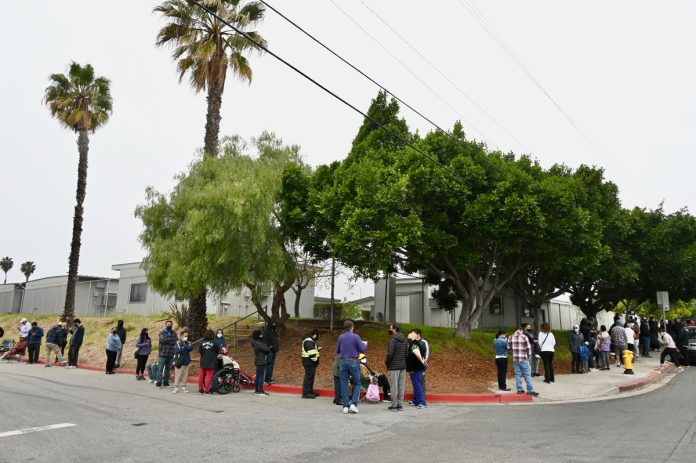
The city of National City is in its second week of a ‘100 Days’ campaign focused on vaccinating 48,000 residents from the 91950 zip code in order to reach herd immunity against COVID-19 by the end of June.
Vaccine clinics are being offered in partnership with the National City Fire Department and University of California San Diego, or UCSD Health center to vaccinate as many people as possible at Las Palmas Elementary school on Saturdays from 8 a.m. to 4 p.m. and on Thursdays at National City library from 9 a.m. to noon.
With a population of that swells to about 100,000 during the workday, National City has had some of the highest case rates in San Diego county since the start of the pandemic and still has one of the highest death tolls in the county.
The neighborhood that already struggles with healthcare inequities and could not limit the spread of the virus throughout the thickest months of the pandemic is now also struggling to make headway with vaccinations.
National City Mayor Alejandra Sotelo-Solis said the biggest challenge at this point is simply connecting people with enough vaccines.
“The gap really is access,” Sotelo-Solis said, with challenges that stem from whether residents know how to make vaccination appointments, how many vaccines are available each week, and whether the city can get resource information out to residents most in need.
“People cannot make appointments if they have not mastered the internet and website portal. While in line at the last vaccine distribution, many people said that was their hiccup. Many also said they could not go to a vaccine site in, say, Point Loma so waiting in line here, locally, is their only chance at getting vaccinated but without consistent information they don’t know what to do,” Sotelo-Solis said.
In an effort to push information out to local residents, a group of volunteers including local firefighters, some South Bay Community Services employees and some union representatives are canvassing neighborhoods this weekend to get the word on how and where to go for vaccinations.
“We’re going old-school, door-to-door and stopping by 12,000 households with printed door hangers to tell people where they can go to get vaccinated,” Sotelo-Solis said.
Getting residents to vaccination sites is one challenge; having enough vaccines at the clinics is another challenge entirely, Sotelo-Solis said, with long lines of residents waiting hours to be jabbed on site.
“Last weekend, we had people lined up at 3:30 a.m. The line was 700 people deep by 9:30 a.m. UCSD brought 800 vaccines to the launch that were supposed to last until 4 p.m. as well as 200 extra. They had gone through everything by mid-afternoon,” Sotelo-Solis said.
The area seems to be stuck in a recovery bottleneck while trying to emerge on the other side of the pandemic, she said.
“As a 60,000 person community, we’re stretched thin. We have one of the highest rates of unemployment, a high rate of people facing eviction, and now we also have to search for vaccines,” Sotelo-Solis said.
Even as an elected official, she said, she does not know exactly how many vaccine appointments are available through the County website.
“I know at the county level, they’re trying their best but we’re going to continue to push for more because this area needs more. What I can do is let people know where to go, how to get there, what time, and let people know they deserve the best access to these vaccines,” Sotelo-Solis said.
Behind the scenes, the city is also gathering information on other healthcare and community resources to distribute at vaccine clinics so time spent waiting in line is also educational and localized for National City residents from arts organization A Reason to Survive, the Department of Parks and Recreation swim classes and open swim times, and information on rent and utility assistance programs.
“We’re not going to turn anyone away at the clinics and there are no questions on immigration status or insurance coverage but we do ask for some sort of identification showing you live in this zip code, like a utility bill because all of this is intended for a disenfranchised community. These clinics are really for grandmothers in wheelchairs, our elderly population, folks who are at risk with health disparities,” Sotelo-Solis said.
Hopefully, anyone who is “computer literate, a dominant English speaker, or has resources to get to and from a major vaccine site” will choose to utilize those resources and open up a place in line for a National City resident in need, she said.
“I’m going to try my hardest to get to 48,000 for herd immunity by June,” Sotelo-Solis said.
She has about 12 weeks left to meet that goal.














